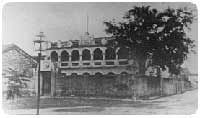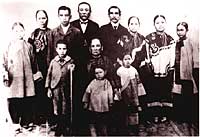|
|
There are countless stories to tell about Dr Sun, his revolution and the role Nanyang
played in it - from his everyday life at Wan Qing Yuan to political assassination attempts. Here are
some of them...
The Life of Dr Sun Yat Sen

|
| Young Dr Sun |
When China experienced incessant domestic trouble and foreign invasion, the people had no means of livelihood as the country was gradually being carved up. It was during this tumultuous period that a person who was to deliver China from her misery was born. He was Sun Yat Sen.
On November 12 1866, Sun Yat Sen was born into a tenant-peasant family in Cuiheng village, Xiangshan county, Guangdong. He had many monikers. He was known as Sun Wen, Deming (childhood name) or Dixiang (name he took at 20). In his adulthood, he assumed the name of Rixin or Yixian (Yat Sen) which his foreign friends refer to him as. When he was conducting revolutionary activities in Japan, he used the Japanese name, Nakayama Kikori (Zhongshan Qiao). On establishing the republic, people referred to him as Mr Zhongshan.
 |
Click here to see Timeline I, chronicling Dr
Sun's life from his birth in 1866 to the success of the Wuchang Revolution
in 1911. |
 |
Click here
for Timeline II, tracing
significant events after 1911 to Dr Sun's death in 1925.
|

|
| Sun Yat Sen residence in Cui
Heng Village, Zhongshan County |
To commemorate his efforts in overthrowing the Qing dynasty and founding the republic, his birthplace, Xiangshan county, was renamed Zhongshan county on April 16 1925.
In 1940, the Nationalist Government decided to make Dr Sun Yat Sen the founding father of the Republic of China.
Dr Sun Yat Sen's Family
Sun Yat Sen's father, Sun Dacheng, was a farmer by day and a midnight watch beater by night. His mother was Madam Yang. Sun had 5 other siblings and he was the 5th child.

|

|
|
Dr Sun's father, Sun Dacheng, and mother, Madam Yang
|
His eldest brother, Sun Mei (Dezhang), was born in 1854. He was older than Sun by 12 years. Sun Mei followed his maternal uncle to Hawaii in 1871. He struck it rich years later. Sun also had elder sister Jinxing, brother Deyou, sister Miaoxi and younger sister Qiuqi.
At 19, Sun agreed to an arranged marriage with fellow villager Lu Muzhen. They had 3 children, son Sun Ke, and daughters Sun Yan and Sun Wan. In his revolutionary days, he got acquainted with a lady named Chen Cuifen and she became his revolutionary companion. Though his companion for many years, Chen was never formally married to Dr Sun. In 1915, after the success of the revolution, he married Song Qingling in Tokyo. Song never had children.
|

|
| Dr Sun, back row, 5th from
left, and family
|
How Dr Sun got his revolutionary ideas
At the tender age of 11, Sun loved to stand under the huge fig tree outside his home to listen to stories about the Taiping rebellion. Impressions of a decadent Qing government and the peasant revolt were strongly etched in his mind.
In 1879, the thirteen-year-old Sun Yat Sen and his mother sailed to Honolulu, Hawaii to join his brother Sun Mei. They travelled in a 2000-ton British steamship named, S.S. Grannock. On the deck of the ship, Sun gazed out to the wide expanse of the ocean and thought, "For the first time I have witnessed such wonders - that of a metal steamship travelling on the vast sea; I must learn such technology to unravel the mysteries of heaven and earth (astronomy and geography)". Since then, Sun became conscious of the power of machines and the advanced level of science and technology developed by the West.

|
| Iolani School in Honolulu |
In Honolulu, Sun Yat Sen enrolled in the Iolani School where he learnt English, Mathematics and Science. From absolutely no knowledge of English, Sun Yat Sen picked up the language so quickly that he was awarded a prize for outstanding achievement in English by King David Kalakaua. Sun Yat Sen then enrolled in Oahu College for further studies but he was soon sent home to China as his brother, Sun Mei was afraid that Sun Yat Sen would embrace Christianity.
When he returned to Cuiheng village in 1883, the scene that met his eyes was a China that demanded exorbitant taxes and levies from its people. The people were conservative, and the schools kept their ancient methods -accept and not question. There was no opportunity for expression of thoughts or opinions.

|
| Dr Sun as a young adult |
One day, while bringing the children out to play with Lu Haodong, he passed by Beijidian, a temple in Cuiheng Village, where he saw many villagers worshipping the Beiji (North Pole) Emperor-God in the temple. Sun was extremely against acts of superstition, so he broke off the hand of the statue. This act incurred much displeasure from fellow villagers.

|
| Diocesan School, Hong Kong |
In November 1883, the 17-year-old Sun Yat Sen left Cuiheng village for Hong Kong. There, he studied English at the Anglican Diocesan Home & Orphanage (later renamed Diocesan Boys' School in 1913). In April 1884, Sun, 17, was
transferred to the Central School of Hong Kong.
True to his brother's earlier concern, Sun was later baptised in Hong Kong by Hickley, an American missionary of the Congressional Church of the United States. Sun believed that the salvation mission of the Christian church was similar to that of a revolution. His conversion to Christianity was related to his revolutionary ideals and push for advancement. His baptismal name, Rixin, means getting rid of the old to welcome the new, and accepting new thoughts and ideas.
In the midst of the Sino-French war in 1885, Hongkongers held strikes and demonstrations to protest against the French invasion of China. On observation of these protests, Sun Yat Sen gathered that the Chinese people had a certain level of awakening. There was still hope for China. Days before the peace settlement between China and France, Feng Zicai defeated a battalion of the French army at Zhennanguan. Strangely, even after defeating the French, China still had to cede land to France. Even the French were baffled. It was after this Sino-French war that Sun Yat Sen vowed to overthrow the Qing dynasty and establish a republic.

|
| Boji Hospital in Guangzhou,
China |
To revolt, Sun Yat Sen needed a suitable occupation to act as a cover. He chose medicine to reach the common people. In the autumn of 1886, the nineteen-year-old Sun Yat Sen enrolled in Nanhua Medical School, a subsidiary of Guangzhou Boji Hospital run by the Presbyterian Church of America. During those times, Dr Sun was a good friend of Zheng Shiliang and Wang Lie. Members of the anti-Qing organisation Hong Men Hui (clandestine gathering), Zheng and Wang provided great assistance to Dr Sun's revolution. That was how Dr Sun got help from members of such secret organisations.
In January 1887, the 21-year-old Sun was transferred to the Hong Kong College of Medicine for Chinese. He graduated 5 years later. This was the period that greatly influenced Sun's revolutionary and career pursuits.

|
| Dr Sun, second from left,
with classmates |
In Hong Kong, Sun Yat Sen, Chen Shaobai, Wang Lie and Yang Heling often discussed political affairs at Yang Heling's shop, Yao Ji. Their debates about revolutionary ideologies and problems lasted over the years they were at medical school. These discussions gave much inspiration to Sun Yat Sen. The foursome was known as "the 4 Desperadoes".
During that era, Hong Kong was orderly and honest compared to China under Manchu
rule. The British and European systems of administration were better. This led Sun Yat Sen to realise that a reform in the government will lead to a better society. China has been without a good government for many years. Hence, Sun Yat Sen decided to launch his revolutionary career after graduation and give up his chances of becoming a doctor. He mentioned, "All my revolutionary thoughts originated from Hong Kong."
Kidnapped in London

|
| Dr Sun's book on his own kidnapping in
London |
On September 30 1896, Dr Sun left New York for Liverpool. He reached London on October 1 and
met his teacher Sir James Cantlie. He was later followed by Qing government spies and bundled off to the Chinese Legation against his will. There, Dr Sun was fiercely interrogated by Qing officials and kept in captivity. He was to be smuggled out of England to China for his execution. Fortunately, Sir James Cantlie broadcasted the news of his capture to the media, which exerted pressure on the Chinese Legation, and secured his
release.
Dr Sun continued to stay in London after that episode and spent his time in the London Museum, reading up on Politics, Foreign affairs, Law, Military Science, Industry and Economics. After studying the London society, Dr Sun had a wider perspective of politics and ideologies. His idea of the Three Principles of the People reached maturation at this stage.
Note: There is a play, "Sun Yat Sen: In the mouth of the dragon", written by Professor Edward F. EmanuEl of California State University (Fresno) regarding Dr Sun's London kidnap. It won the Mark David Cohen award for Best Original Play in the USA presented by the John F. Kennedy Center For the Performing Arts in Washington DC. The play also finished third in the Pulitzer Prize (Drama Voting). The play is being published in the USA by Dramatic Publishing Company and is now seeking interested producers of the play internationally in English and Chinese.
 The Revolution in China...
The Revolution in China...
back to top
|


